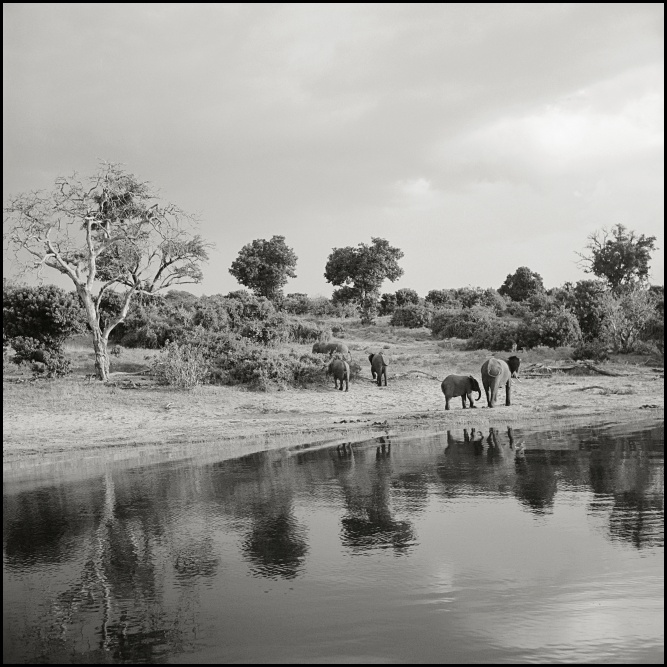chobe nocturne...
The evening performance is over, the elephants saunter off the stage. Many viewers of this series may be relieved to see the end of these elephants. Even in real life, the excitement and magic of the first encounter with these great creatures can soon wear off. They are so thick along the Chobe, so commonplace, they quickly lose their novelty. After a while it seems the bush is practically overrun with them. One may even find them wandering the streets of Kasane. Here their big cute Disney lovability suddenly becomes something ominous and threatening and thuggish. In some parts of Africa the elephants are so abundant they wreak havoc on the environment. A few countries have even established programs of thinning the herds from time to time, a practice known as "culling". Of course culling means killing, and this inspires international controversy. On one side of this controversy are the yuppies and tourists and animal rights activists that normally don't get within 10,000 kilometres of the creatures. On the other side are the Africans who actually have to live with the beasts, whose gardens are destroyed by them, whose crops and entire livelihood may be thrashed and trashed in a single elephant moment. I am sure gardeners in Europe and America have to deal with many unpleasant pests. But I doubt that any of them could ever begin to face the massive terror of a voracious pachyderm. Getting back to this series, photographically speaking, we should probably cull a few of our own elephants. Even I know we have done these elephants to death. I'm glad I brought the Rolleiflex on this trip, though. I like having these images that convey the full ambience of the river with its inhabitants. Plus, I have had the added pleasure of seeing these images at much higher resolution, over 8 times the size shown above. The detail that emerges then is amazing, the hidden animals, the snowy egrets, the bristly hair on the elephant backs. Thanks for the memories, Mr. Carl Zeiss. Thank you for that sweet and fine Tessar lens! Unfortunately, many/most of the scans in this series haven't done justice to the potential of the original negative. As an example, I recently reworked the photograph shown with "big & widdle". It is now much improved over the original effort, and more improvements are certainly possible. In fact, most of the photographs we show here should be similarly redone. But will I ever go back to them? As I watch the elephants move away, I take a moment to reflect on our journey up till now. All things considered, it has been a fine evening on the water. The river air, the African light, the encounters with wildness, all have been most invigorating. Teshka and I have definitely grown closer on this excursion, too. As we admire this scene together, she tenderly squeezes my good arm and makes me another one of her little jokes. "You may not be hung like an elephant," she says. "But at least your butt is as fat as one." Chobe River, Botswana, April 2008. Rolleiflex T, Neopan 400. |
